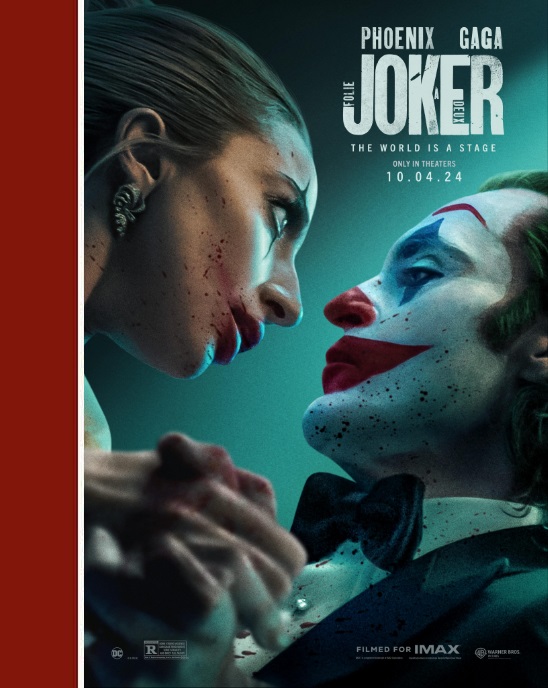

The first time a sequel to Todd Phillip’s 2019 film Joker was announced, I immediately had mixed feelings about it. I firmly believed Joker didn’t need a sequel; it was perfect as a standalone film. Everything about it — from the technical aspects to the creative elements — is perfect (for both the Batman comic book fans and the uninitiated ones).
One of the great things about this film, in my opinion, is its high rewatch value; you could watch the film multiple times and still be captivated. The two strongest elements of the film are also its heart and soul: Joaquin Phoenix’s performance, and Hildur Guðnadóttir’s score. I believe Joker has one of Phoenix’s best acting performances ever. Connecting itself to the larger Batman mythos, this film was fine as a standalone Joker origin story; but like all comic book adaptations based on popular characters, the room for possible sequels was always there. Presumably, an incorporation of Bruce Wayne/Batman into the second instalment wouldn’t have been much of a surprise. The final scene of Joker has a cinematic reiteration of the iconic image of the child Bruce Wayne standing horrified and traumatised near the murdered bodies of his parents, as Joker laughs maniacally in the background. The two future arch-enemies in this scene are separated in space and time, but are brought together by fate and also by the madness that has consumed Gotham city. This shot becomes effective in Joker in two ways: first, it shows the greater implication of Arthur Fleck’s actions, which results into Bruce Wayne becoming an orphan and getting his childhood and innocence snatched away from him in the most violent way possible. Second, it reminds the audience of the larger universe that these characters are a part of, and hints at where this will eventually lead these characters into, tying up the fates of Joker and Batman. Joker (unintentionally) starts the reaction that leads to the birth of the Dark Knight. But the film also makes it clear that it’s a different storyline from the (pre)existing ones; it’s separate from its contemporary popular media iterations of the Batman mythos, keeping the possibilities of turning this film into a franchise. So, although a sequel was unnecessary, it was never unwarranted.
But does the sequel pick up from this point? Unfortunately, it doesn’t. When Lady Gaga was announced as Harley Quinn (Harleen Quinzel) in the film, and with the release of the first trailer, it was more or less conveyed that the film would be a musical. Director Todd Phillips, however, addressed the rumours at the Las Vegas Comic-Con 2024 by saying that it wouldn’t really be a musical but a film where music would be “an essential element.” Personally, I had no issues with Joker 2 being a musical. As long as we were getting a Batman mythos-related film, especially with Joaquin Phoenix reprising his role as the Joker, I was ready to welcome with open arms whatever was being offered. I did have a hunch that the sequel would not outdo its predecessor, but I still wasn’t prepared for the underwhelming mess that was Folie à Deux. Thankfully, I had gone to the cinema with my friends, so I had people I could share my displeasure with in real-time. (On a side note, that’s something that I never do, but it had become difficult to watch this film without letting out a few groans every now and then.)

Folie à Deux refers to a rare clinical syndrome or mental disorder where psychological delusions are transmitted and shared between two people.
The film is an exploration of Joker and Harley’s relationship, but what it achieves through that exploration, is something that perhaps only the fans of this film could explain. I am not going to point out the obvious plotholes, or elaborate on the “covert” metaphors that have become a staple of video essayists on YouTube, and I’m also not going to pull instances of “deep” symbolism out of my hat, because analyses of this sort could turn even Sharknado into a riveting text. There’s so little in terms of story in the film that even if I disregarded my displeasure over the filmmakers’ treatment of the main characters, I’d still be disgruntled.
Folie à Deux refers to a rare clinical syndrome or mental disorder where psychological delusions are transmitted and shared between two people. There’s nothing consequential about having this in the film’s title when you know the film deals with Joker and Harley Quinn, two mentally unstable characters. The fact that many of the song and dance sequences in the film are Joker and Harley’s delusions, and that the film points fingers at the justice system and society, doesn’t necessarily make it “intelligent.” The latter could’ve been done in several other effective ways, but the film does it in the most dreary, uninspired way possible, going so far as to having characters narrate events from the previous film. All it achieves through this is an undoing of many of the good things from the previous film, if not of the entire film itself.
As Todd Phillips had stated, music does play an essential role in the film. But he should’ve also made it clear that half the film is comprised of song and dance sequences. Even that can be excused if the film in question is a musical, but the song and dance sequences do not achieve anything in terms of plot or character development. The performances of Joaquin Phoenix and Lady Gaga (who plays a version of Harley Quinn who plays a version of Lady Gaga) make the initial numbers watchable, but the repetitive musical breakouts become annoying after a point. The only exception to this, in the later part of the film, is a sequence where the film turns meta (there’s honestly nothing remarkable about it), as Joker and Harley talk about giving the audience “what they want,” following it up with a scene of Joker brutally bashing the head of a judge with a hammer. From there, the film goes back to being an unexciting musical courtroom drama.
SPOILER ALERT:
Joker (2019) ends with Arthur embracing his darker side and turning into the Joker, which is conveyed satisfactorily through a shot of Arthur drawing a smile on his face with his blood, as Gotham city burns all around him. The sequel, however, begins with him having gone back to being depressed and pitiable. Now, it could be said that it was the prison that made him like this with the constant abuse and all the medication, but doesn’t that completely steer away from the profundity that the previous film was so successful in achieving? The sequel didn’t quite need Harley (the film doesn’t use her anyway); it just needed Arthur to be miserable and helpless again. The events of Folie à Deux couldn’t have been possible at all if it had begun from the point where the previous film had ended. And to make sure nobody raises this question, the film ends with the revelation that Arthur Fleck was never really the Joker. When a random prisoner stabs Arthur to death and then carves a smile into his own face, hinting at the fact that he’s the “real” Joker, did the studio expect the audience to jump out of their seats and burst into cheers? So, Arthur was never the Joker but the result of an ideological construct that the people of Gotham had forced upon him. What am I supposed to do with this revelation? Look around myself and say, “That’s so real!”? Feel sorry for Arthur? Or wait for another sequel?
What, then, was the purpose of the first film? Why on earth did the filmmakers pick up elements from the Batman mythos, only to devalue them? The easy answer is, of course, money. They could’ve worked on the same story, while only changing the names and locations, and it wouldn’t have been much of an issue. But if you are marketing the film as a Joker film and then doing this, I don’t know what to say to you. If I’m supposed to be impressed by this film just for its “unique take” on the Joker, then I should also be impressed by all the previous interpretations of the character, since each of them has been a unique take, and that includes Jared Leto’s version in Suicide Squad (2016), which has been almost unanimously panned by critics and fans alike.
It’s baffling how the director who made one of the best Joker films has made this, and that too, as a sequel. Fans and defenders of Joker: Folie à Deux may call it unique and philosophical all they want, but I still see it as a feature-length music video aspiring to be a quirky Disney musical and failing in its attempt to do so.
Aditya Modak
Runner-up of the FIPRESCI-India 2023 competition for the best upcoming film reviewer, he writes for the FCCI Journal of Indian Cinema, and is also the author of a fiction novel, ‘Arachnid’. He is presently doing his PhD in Film Studies at Jadavpur University.

Share Widely

